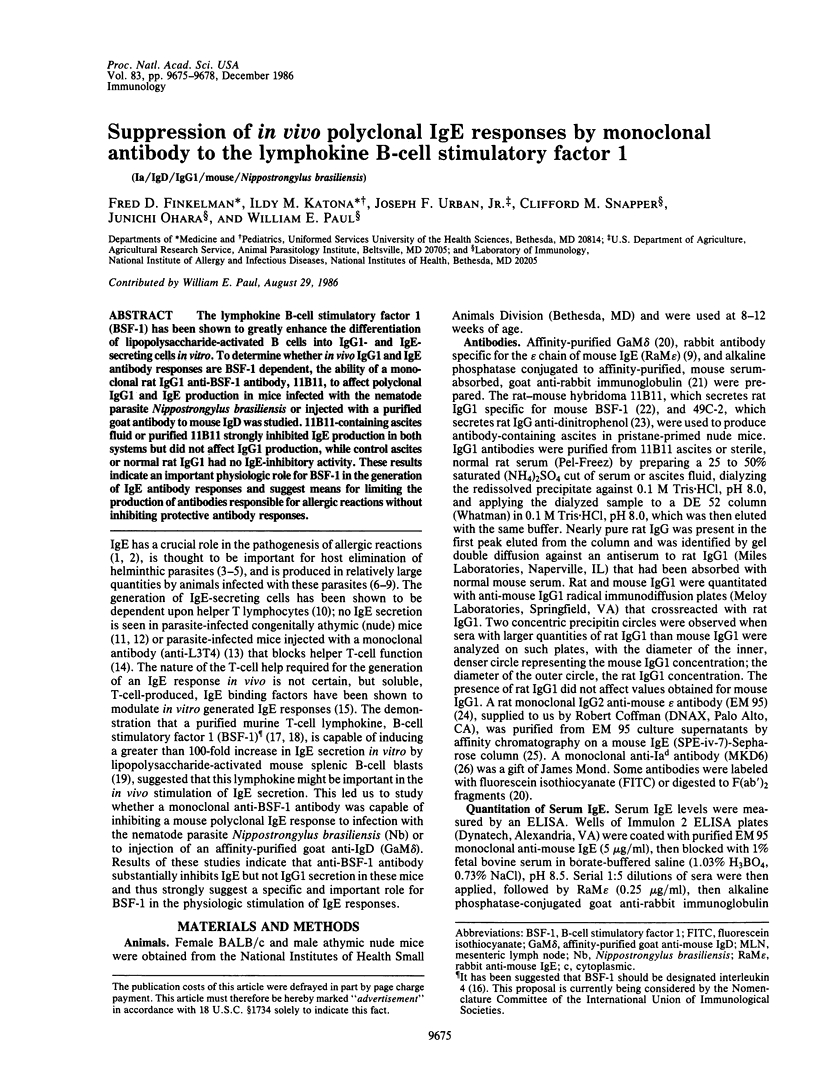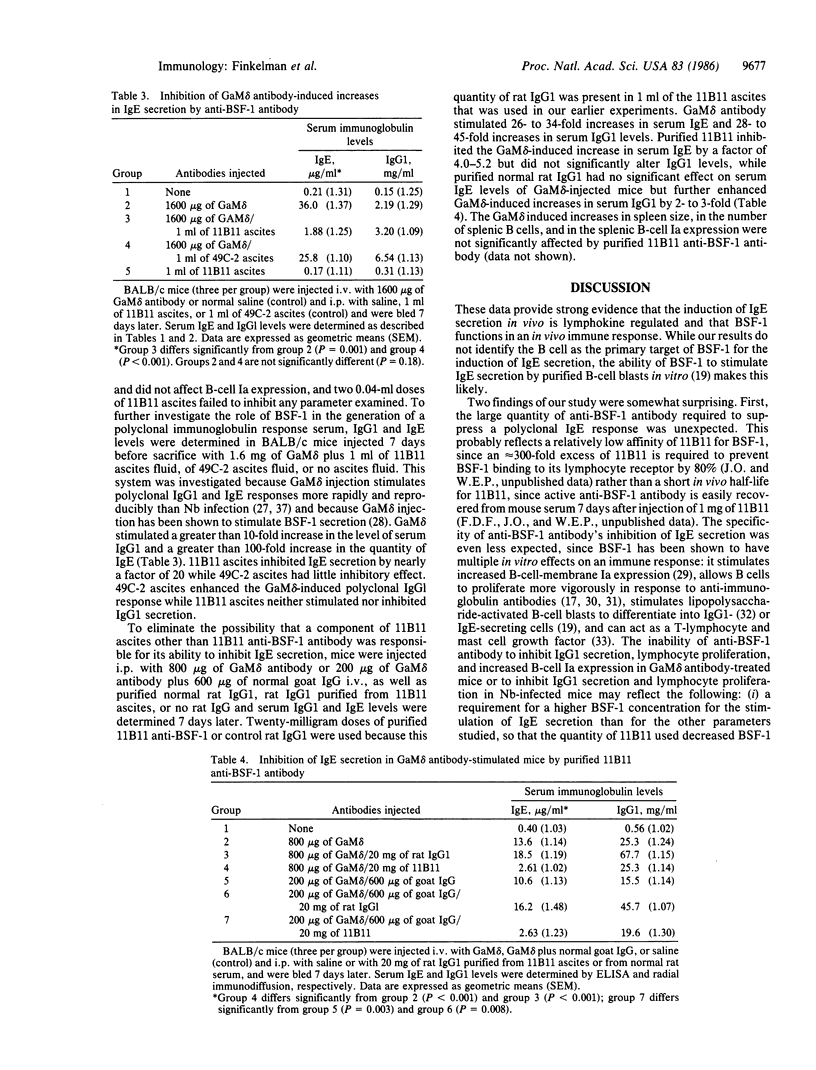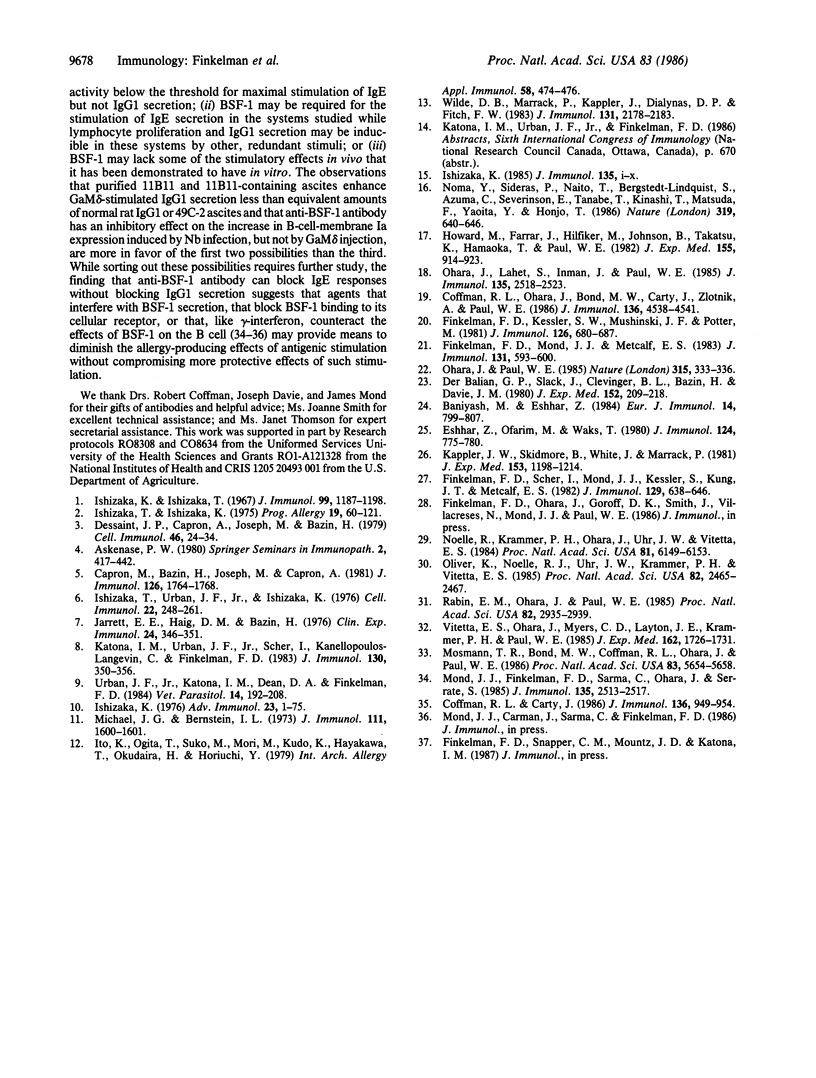Abstract
The lymphokine B-cell stimulatory factor 1 (BSF-1) has been shown to greatly enhance the differentiation of lipopolysaccharide-activated B cells into IgG1- and IgE-secreting cells in vitro. To determine whether in vivo IgG1 and IgE antibody responses are BSF-1 dependent, the ability of a monoclonal rat IgG1 anti-BSF-1 antibody, 11B11, to affect polyclonal IgG1 and IgE production in mice infected with the nematode parasite Nippostrongylus brasiliensis or injected with a purified goat antibody to mouse IgD was studied. 11B11-containing ascites fluid or purified 11B11 strongly inhibited IgE production in both systems but did not affect IgG1 production, while control ascites or normal rat IgG1 had no IgE-inhibitory activity. These results indicate an important physiologic role for BSF-1 in the generation of IgE antibody responses and suggest means for limiting the production of antibodies responsible for allergic reactions without inhibiting protective antibody responses.
Full text
PDF



Selected References
These references are in PubMed. This may not be the complete list of references from this article.
- Baniyash M., Eshhar Z. Inhibition of IgE binding to mast cells and basophils by monoclonal antibodies to murine IgE. Eur J Immunol. 1984 Sep;14(9):799–807. doi: 10.1002/eji.1830140907. [DOI] [PubMed] [Google Scholar]
- Capron M., Bazin H., Joseph M., Capron A. Evidence for IgE-dependent cytotoxicity by rat eosinophils. J Immunol. 1981 May;126(5):1764–1768. [PubMed] [Google Scholar]
- Coffman R. L., Carty J. A T cell activity that enhances polyclonal IgE production and its inhibition by interferon-gamma. J Immunol. 1986 Feb 1;136(3):949–954. [PubMed] [Google Scholar]
- Coffman R. L., Ohara J., Bond M. W., Carty J., Zlotnik A., Paul W. E. B cell stimulatory factor-1 enhances the IgE response of lipopolysaccharide-activated B cells. J Immunol. 1986 Jun 15;136(12):4538–4541. [PubMed] [Google Scholar]
- Der Balian G. P., Slack J., Clevinger B. L., Bazin H., Davie J. M. Subclass restriction of murine antibodies. III. Antigens that stimulate IgG3 in mice stimulate IgG2c in rats. J Exp Med. 1980 Jul 1;152(1):209–218. doi: 10.1084/jem.152.1.209. [DOI] [PMC free article] [PubMed] [Google Scholar]
- Dessaint J. P., Capron A., Joseph M., Bazin H. Cytophilic binding of IgE to the macrophage. II. Immunologic release of lysosomal enzyme from macrophages by IgE and anti-IgE in the rat: a new mechanism of macrophage activation. Cell Immunol. 1979 Aug;46(1):24–34. doi: 10.1016/0008-8749(79)90242-9. [DOI] [PubMed] [Google Scholar]
- Eshhar Z., Ofarim M., Waks T. Generation of hybridomas secreting murine reaginic antibodies of anti-DNP specificity. J Immunol. 1980 Feb;124(2):775–780. [PubMed] [Google Scholar]
- Finkelman F. D., Kessler S. W., Mushinski J. F., Potter M. IgD-secreting murine plasmacytomas: identification and partial characterization of two IgD myeloma proteins. J Immunol. 1981 Feb;126(2):680–687. [PubMed] [Google Scholar]
- Finkelman F. D., Mond J. J., Metcalf E. S. Effects of neonatal anti-delta antibody treatment on the murine immune system. I. Suppression of development of surface IgD+ B cells and expansion of a surface IgM+ IgD- B lymphocyte population. J Immunol. 1983 Aug;131(2):593–600. [PubMed] [Google Scholar]
- Finkelman F. D., Scher I., Mond J. J., Kessler S., Kung J. T., Metcalf E. S. Polyclonal activation of the murine immune system by an antibody to IgD. II. Generation of polyclonal antibody production and cells with surface IgG. J Immunol. 1982 Aug;129(2):638–646. [PubMed] [Google Scholar]
- Howard M., Farrar J., Hilfiker M., Johnson B., Takatsu K., Hamaoka T., Paul W. E. Identification of a T cell-derived b cell growth factor distinct from interleukin 2. J Exp Med. 1982 Mar 1;155(3):914–923. doi: 10.1084/jem.155.3.914. [DOI] [PMC free article] [PubMed] [Google Scholar]
- Ishizaka K. Cellular events in the IgE antibody response. Adv Immunol. 1976;23:1–75. doi: 10.1016/s0065-2776(08)60318-1. [DOI] [PubMed] [Google Scholar]
- Ishizaka K., Ishizaka T. Identification of gamma-E-antibodies as a carrier of reaginic activity. J Immunol. 1967 Dec;99(6):1187–1198. [PubMed] [Google Scholar]
- Ishizaka K. Twenty years with IgE: from the identification of IgE to regulatory factors for the IgE response. J Immunol. 1985 Jul;135(1):i–x. [PubMed] [Google Scholar]
- Ishizaka T., Ishizaka K. Biology of immunoglobulin E. Molecular basis of reaginic hypersensitivity. Prog Allergy. 1975;19:60–121. [PubMed] [Google Scholar]
- Ishizaka T., Urban J. F., Jr, Ishizaka K. IgE formation in the rat following infection with Nippostrongylus brasiliensis. I. Proliferation and differentiation of IgE-bearing cells. Cell Immunol. 1976 Mar 15;22(2):248–261. doi: 10.1016/0008-8749(76)90027-7. [DOI] [PubMed] [Google Scholar]
- Ito K., Ogita T., Suko M., Mori M., Kudo K., Hayakawa T., Okudaira H., Horiuchi Y. IgE levels in nude mice. Int Arch Allergy Appl Immunol. 1979;58(4):474–476. doi: 10.1159/000232229. [DOI] [PubMed] [Google Scholar]
- Jarrett E. E., Haig D. M. Time course studies on rat IgE production in N. Brasiliensis infection. Clin Exp Immunol. 1976 May;24(2):346–351. [PMC free article] [PubMed] [Google Scholar]
- Kappler J. W., Skidmore B., White J., Marrack P. Antigen-inducible, H-2-restricted, interleukin-2-producing T cell hybridomas. Lack of independent antigen and H-2 recognition. J Exp Med. 1981 May 1;153(5):1198–1214. doi: 10.1084/jem.153.5.1198. [DOI] [PMC free article] [PubMed] [Google Scholar]
- Katona I. M., Urban J. F., Jr, Scher I., Kanellopoulos-Langevin C., Finkelman F. D. Induction of an IgE response in mice by Nippostrongylus brasiliensis: characterization of lymphoid cells with intracytoplasmic or surface IgE. J Immunol. 1983 Jan;130(1):350–356. [PubMed] [Google Scholar]
- Michael J. G., Bernstein I. L. Thymus dependence of reaginic antibody formation in mice. J Immunol. 1973 Nov;111(5):1600–1601. [PubMed] [Google Scholar]
- Mond J. J., Finkelman F. D., Sarma C., Ohara J., Serrate S. Recombinant interferon-gamma inhibits the B cell proliferative response stimulated by soluble but not by Sepharose-bound anti-immunoglobulin antibody. J Immunol. 1985 Oct;135(4):2513–2517. [PubMed] [Google Scholar]
- Mosmann T. R., Bond M. W., Coffman R. L., Ohara J., Paul W. E. T-cell and mast cell lines respond to B-cell stimulatory factor 1. Proc Natl Acad Sci U S A. 1986 Aug;83(15):5654–5658. doi: 10.1073/pnas.83.15.5654. [DOI] [PMC free article] [PubMed] [Google Scholar]
- Noelle R., Krammer P. H., Ohara J., Uhr J. W., Vitetta E. S. Increased expression of Ia antigens on resting B cells: an additional role for B-cell growth factor. Proc Natl Acad Sci U S A. 1984 Oct;81(19):6149–6153. doi: 10.1073/pnas.81.19.6149. [DOI] [PMC free article] [PubMed] [Google Scholar]
- Noma Y., Sideras P., Naito T., Bergstedt-Lindquist S., Azuma C., Severinson E., Tanabe T., Kinashi T., Matsuda F., Yaoita Y. Cloning of cDNA encoding the murine IgG1 induction factor by a novel strategy using SP6 promoter. Nature. 1986 Feb 20;319(6055):640–646. doi: 10.1038/319640a0. [DOI] [PubMed] [Google Scholar]
- Ohara J., Lahet S., Inman J., Paul W. E. Partial purification of murine B cell stimulatory factor (BSF)-1. J Immunol. 1985 Oct;135(4):2518–2523. [PubMed] [Google Scholar]
- Ohara J., Paul W. E. Production of a monoclonal antibody to and molecular characterization of B-cell stimulatory factor-1. Nature. 1985 May 23;315(6017):333–336. doi: 10.1038/315333a0. [DOI] [PubMed] [Google Scholar]
- Oliver K., Noelle R. J., Uhr J. W., Krammer P. H., Vitetta E. S. B-cell growth factor (B-cell growth factor I or B-cell-stimulating factor, provisional 1) is a differentiation factor for resting B cells and may not induce cell growth. Proc Natl Acad Sci U S A. 1985 Apr;82(8):2465–2467. doi: 10.1073/pnas.82.8.2465. [DOI] [PMC free article] [PubMed] [Google Scholar]
- Rabin E. M., Ohara J., Paul W. E. B-cell stimulatory factor 1 activates resting B cells. Proc Natl Acad Sci U S A. 1985 May;82(9):2935–2939. doi: 10.1073/pnas.82.9.2935. [DOI] [PMC free article] [PubMed] [Google Scholar]
- Urban J. F., Jr, Katona I. M., Dean D. A., Finkleman F. D. The cellular IgE response of rodents to infection with Nippostrongylus brasiliensis, Trichinella spiralis and Schistosoma mansoni. Vet Parasitol. 1984 Jun;14(3-4):193–208. doi: 10.1016/0304-4017(84)90091-8. [DOI] [PubMed] [Google Scholar]
- Vitetta E. S., Ohara J., Myers C. D., Layton J. E., Krammer P. H., Paul W. E. Serological, biochemical, and functional identity of B cell-stimulatory factor 1 and B cell differentiation factor for IgG1. J Exp Med. 1985 Nov 1;162(5):1726–1731. doi: 10.1084/jem.162.5.1726. [DOI] [PMC free article] [PubMed] [Google Scholar]
- Wilde D. B., Marrack P., Kappler J., Dialynas D. P., Fitch F. W. Evidence implicating L3T4 in class II MHC antigen reactivity; monoclonal antibody GK1.5 (anti-L3T4a) blocks class II MHC antigen-specific proliferation, release of lymphokines, and binding by cloned murine helper T lymphocyte lines. J Immunol. 1983 Nov;131(5):2178–2183. [PubMed] [Google Scholar]


